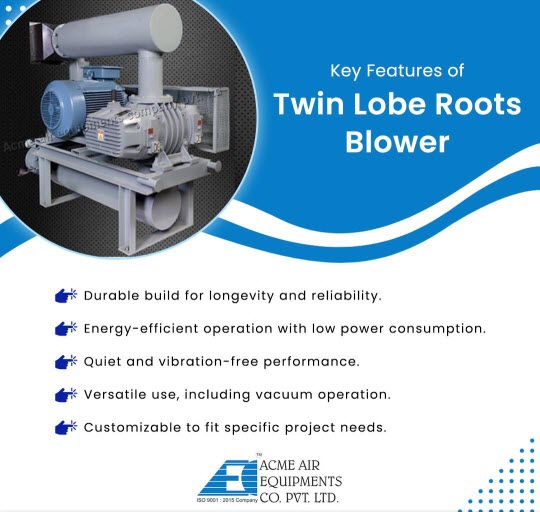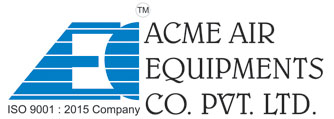Table of Contents
Proper maintenance is crucial for ensuring the optimal performance and longevity of twin lobe and tri lobe roots blowers. These machines are vital components in industrial operations, and a well-maintained blower reduces downtime, enhances efficiency, and minimizes repair costs. Here’s a detailed, point-wise guide to maintaining your twin lobe or tri lobe roots blower, featuring best practices and insights for owners, operators, and maintenance teams.
1. Follow the Manufacturer’s Guidelines
- Always adhere to the maintenance schedule and recommendations provided by the blower manufacturer or supplier.
- Use approved spare parts and lubricants to avoid performance issues.
- Specific guidelines for tri lobe blower designs can vary, so refer to the manual for exact details.
2. Perform Regular Visual Inspections
- Inspect the blower for signs of wear, damage, or leaks in the casing and seals.
- Check for misalignment of the lobes and ensure that the machine’s parts are functioning smoothly.
- Examine belts, couplings, and fasteners for proper tension and alignment.
3. Monitor Lubrication Levels
- Maintain the correct oil levels in the tri lobe vacuum blower to ensure smooth operation of the bearings and gear mechanisms.
- Use high-quality lubricants recommended by the tri lobe blower manufacturers or exporters.
- Schedule regular oil changes to prevent contamination and excessive wear.
4. Clean and Replace Filters
- Regularly clean or replace air filters to prevent blockages and ensure proper airflow.
- Blocked filters can overwork the blower, reducing efficiency and lifespan.
- Filters in high-demand models like tri lobe roots blowers should be inspected more frequently in dusty or dirty environments.
5. Check for Unusual Vibrations or Noise
- Vibrations or excessive noise can indicate misalignment, loose components, or internal damage.
- Address any irregularities promptly to avoid further complications.
- Tri lobe blower designs often feature enhanced stability, but even these require regular checks to maintain performance.

6. Inspect Seals and Bearings
- Ensure the seals are intact to prevent leaks and maintain optimal pressure.
- Check bearings for wear and replace them when needed to avoid costly repairs.
- Bearings in tri lobe blowers are precision components that require consistent maintenance to ensure smooth operation.
7. Maintain Proper Clearance Settings
- The clearance between the lobes and the casing should align with the manufacturer’s specifications.
- Incorrect clearance can lead to reduced efficiency or even damage to the blower.
- Tri lobe blower designs may require slightly different settings than twin lobe counterparts, so consult the manual or your supplier
8. Keep the Blower Clean
- Regularly clean the external surfaces of the blower to remove dust, dirt, and debris.
- In environments with higher contamination, cleaning schedules for tri lobe blowers should be more frequent.
- A clean blower operates more efficiently and is less prone to overheating.
9. Monitor Operating Conditions
- Ensure the blower is operating within the recommended temperature, pressure, and speed ranges.
- Overloading or operating beyond the specified limits can shorten the life of the machine.
- For tri lobe roots blowers, this is particularly important as they are designed for higher capacities and must be used within their operational scope.
10. Conduct Routine Performance Testing
- Test the blower’s performance regularly to identify issues before they escalate.
- Measure parameters such as airflow, pressure, and temperature to ensure the blower meets operational requirements.
- Work with experienced suppliers or service providers for detailed diagnostics.
11. Train Your Operators
- Provide comprehensive training to operators on how to use and maintain the blower correctly.
- Proper handling ensures that potential damage is minimized, and the machine operates efficiently.
12. Use Genuine Parts
- Always source replacement parts from trusted tri lobe blower exporters or authorized dealers.
- Using counterfeit or low-quality parts can lead to premature failure and void warranties.
13. Schedule Preventive Maintenance
- Create and adhere to a preventive maintenance schedule, including inspections, lubrication, and part replacements.
- Preventive maintenance minimizes downtime and extends the blower’s life.
14. Work with Reputable Service Providers
- Choose reliable manufacturers or service providers for repairs and maintenance
- Experienced tri lobe roots blower suppliers often provide support and spare parts to ensure optimal performance.
15. Upgrade When Necessary
- If your blower no longer meets operational needs, consider upgrading to newer models such as tri lobe roots blowers.
- Modern designs offer improved efficiency, reduced noise, and better handling of higher pressures.
Benefits of Proper Maintenance
Maintaining your twin lobe or tri lobe roots blower ensures:
- Enhanced operational efficiency.
- Lower energy consumption.
- Reduced downtime and maintenance costs.
- Extended equipment lifespan.
By adhering to these maintenance tips, industries can maximize the performance and reliability of their blowers, ensuring uninterrupted operations.
FAQs About Twin Lobe and Tri Lobe Roots Blower
Twin lobe blowers have two lobes, while tri lobe blowers feature three lobes, offering improved efficiency and reduced noise levels.
Use high-quality, manufacturer-approved lubricants for optimal performance and to prevent gear and bearing wear.
It is best to use genuine parts supplied by trusted manufacturers and exporters to ensure reliability and avoid warranty issues.
Preventive maintenance minimizes unexpected breakdowns, enhances efficiency, and prolongs the blower’s lifespan.
About Author

CEO
Mr. Vishwesh Pardeshi is the CEO of Acme Air Equipments Company Pvt. Ltd., an industrial and engineering goods manufacturing company based in Ahmedabad, Gujarat (India). He has taken over the responsibility from founding Partners and Directors of the Company, and is now leading a talented group of professionals since 2020 by bringing in vast industrial and management expertise. By qualification, he holds a Bachelor Degree in Mechanical Engineering and also holds a MBA degree from reputed institutes. Under his leadership, the Company has successfully executed prestigious projects by delivering high quality and world class products from a state of the art manufacturing facility which combines CNC-enabled precision manufacturing and strong after sales support. In line with the Vision, Mission and Core Values of the Organization, Mr. Vishwesh Pardeshi continues to drive Quality, Reliability and Global Expansion at Acme Air Equipments Co. Pvt. Ltd.








